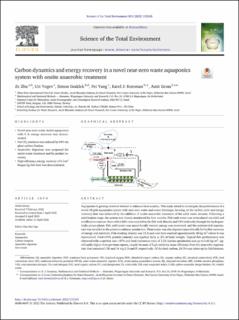| dc.contributor.author | Zhu, Ze | |
| dc.contributor.author | Yogev, Uri | |
| dc.contributor.author | Goddek, Simon | |
| dc.contributor.author | Yang, Fei | |
| dc.contributor.author | Keesman, Karel J. | |
| dc.contributor.author | Gross, Amit | |
| dc.date.accessioned | 2023-03-01T15:54:19Z | |
| dc.date.available | 2023-03-01T15:54:19Z | |
| dc.date.created | 2022-09-01T14:11:05Z | |
| dc.date.issued | 2022 | |
| dc.identifier.citation | Science of the Total Environment. 2022, 833, 155245. | en_US |
| dc.identifier.issn | 0048-9697 | |
| dc.identifier.uri | https://hdl.handle.net/11250/3055115 | |
| dc.description.abstract | Aquaponics is gaining renewed interest to enhance food security. This study aimed to investigate the performance of a novel off-grid aquaponics system with near-zero water and waste discharge, focusing on the carbon cycle and energy recovery that was achieved by the addition of onsite anaerobic treatment of the solid waste streams. Following a stabilization stage, the system was closely monitored for four months. Fish tank water was recirculated via solid and nitrification reactors, from which 66% was recycled to the fish tank directly and 34% indirectly through the hydroponically grown plants. Fish solid waste was anaerobically treated, energy was recovered, and the nutrient-rich supernatant was recycled to the plants to enhance production. Plant waste was also digested anaerobically for further recovery of energy and nutrients. Fish stocking density was 15.3 and over time reached approximately 40 kg/m3 where it was maintained. Feed (45% protein content) was applied daily at 2% of body weight. Typical fish performance was observed with a survival rate >97% and feed conversion ratio of 1.33. Lettuce production was up to 5.65 kg/m2, significantly higher than previous reports, largely because of high nutrients reuse efficiency from the anaerobic supernatant that contained 130 and 34 mg/L N and P, respectively. Of the feed carbon, 24.5% was taken up by fish biomass. Fish solid wastes contained 38.2% carbon, of which 91.9% was recovered as biogas (74.5% CH4). Biogas production was 0.84 m3/kg for fish sludge and 0.67 m3/kg for dry plant material. CO2 sequestration was 1.4 higher than the feed carbon, which reduced the system's carbon footprint by 64%. This study is the first to demonstrate highly efficient fish and plant production with near-zero water and waste discharge and with energy recovery that can potentially supply the system's energy demand. | en_US |
| dc.language.iso | eng | en_US |
| dc.publisher | Elsevier | en_US |
| dc.rights | Navngivelse 4.0 Internasjonal | * |
| dc.rights.uri | http://creativecommons.org/licenses/by/4.0/deed.no | * |
| dc.title | Carbon dynamics and energy recovery in a novel near-zero waste aquaponics system with onsite anaerobic treatment | en_US |
| dc.title.alternative | Carbon dynamics and energy recovery in a novel near-zero waste aquaponics system with onsite anaerobic treatment | en_US |
| dc.type | Peer reviewed | en_US |
| dc.type | Journal article | en_US |
| dc.description.version | publishedVersion | en_US |
| dc.rights.holder | © 2022 The Authors. | en_US |
| dc.source.pagenumber | 0 | en_US |
| dc.source.volume | 833 | en_US |
| dc.source.journal | Science of the Total Environment | en_US |
| dc.identifier.doi | 10.1016/j.scitotenv.2022.155245 | |
| dc.identifier.cristin | 2047934 | |
| dc.source.articlenumber | 155245 | en_US |
| cristin.ispublished | true | |
| cristin.fulltext | original | |
| cristin.qualitycode | 2 | |

